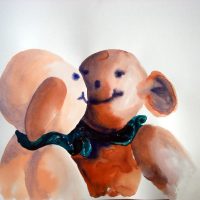The journey mentioned in the title is metaphoric on the one hand, as it signifies a self-examination in part; on the other hand, it is also concrete, as it also casts a glance beneath the skin. Particularly in the case of Mária Chilf, we can speak of the metaphoric interpretation of the title, as she engages with the interpretation of ourselves and the world, the possibility for emerging from ourselves. Her latest aquarelles, composed from a number of elements, are likewise the projections of mental-psychic experiences. While she shows a number of pictures, which may even have their own titles, nevertheless these numerous details comprise a unit in its entirety, or a single artwork, under the title Incidental Horizon. We are witness to the bittersweet humour of her works, if we think of The Taming of the Monster, Smiling Practice in the Mirror or Attempts at Border-Crossing.
In her works, Csilla Koszeghy criticises the medical and sociological representations of the body by way of presenting the female breast in various situations. The works in the show approach the subject in three different ways. In the first three lithographs, we see a detail or cross-section of the breast, imitating the diagrams of medical books, though instead of the usual medical explanations in Latin, quotations from the “classics” of women’s art – Frida Kahlo, Georgia O’Keeffe and Virginia Woolf – can be read. In the following section, the artist has embroidered the lymphatic and blood-vessel system of the breasts onto large-scale photographs, or simply a few stylised internal organs. The third group of her works comprises the witty small-scale photos in which synthetic breast-implants appear in various unexpected situations, e.g., on the headlamp of a car, in graffiti, on shutters, etc. In contrast with the delicacy of the lithographs, the strident sight of the embroidered photos may be surprising, not to mention the various humorous, or even morbid appearances of the breast-implants.
In the 3D video animation of the third artist in the exhibition, Ivó Kovács, entitled Re:vision, we are witness to the story of creation, in which man is created from water. This work may be placed in parallel as a transcription, by way of the role of water and the appearance of life and death, with the works of Bill Viola. In Ivó Kovács’s previous film, entitled Crossing, he performed a visual journey, literally, through the insides of man, and while that film concluded with death, the current work culminates in the creation of life. This piece is also a good example of how it is possible to represent lyrical and transcendental thinking through a technical medium.
Thus, the title – Inner Journey – refers equally to the physical and the spiritual journey through ourselves, on the path to both physical and mental-psychic self-knowledge. The three potential paths present what is hidden – both in the strictest sense of the word, and in a figurative sense – beneath the surface. The works are unusual, at times moving, though they also tend to approach man from a humorous aspect, as well. And it is precisely this that provides the common voice in the works of all three: a sort of uncommon cross-section of mordant irony and sensitivity.
Andrea Bordács


